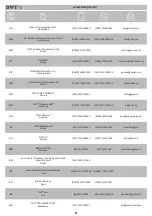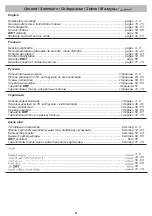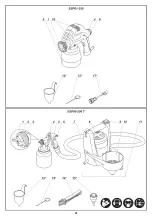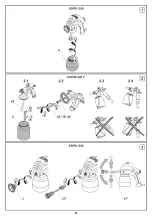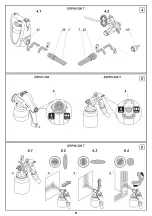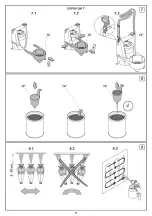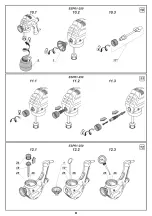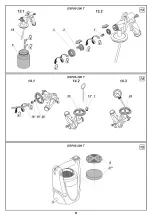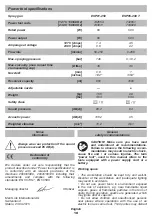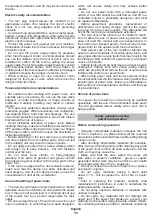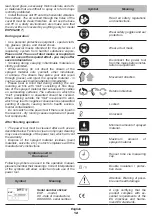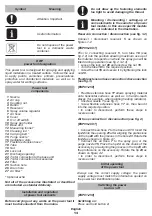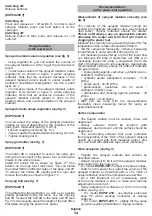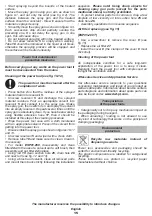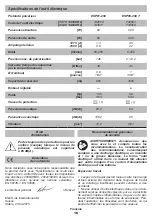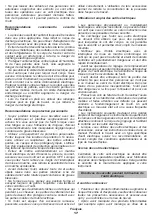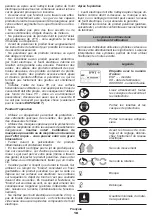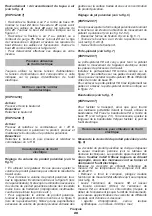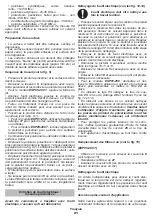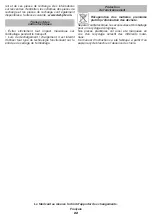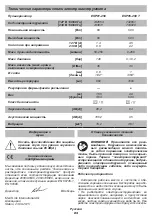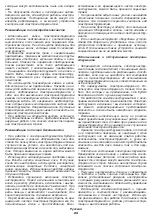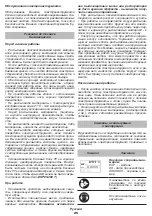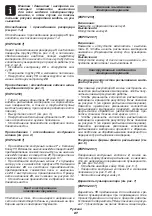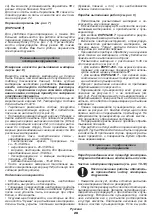
14
English
Switching off:
Release button
4
.
[ESP05-200 T]
Switching on:
Press and release on / off switch
9
. In order to start
spraying material, press and hold button
4
on the
spray gun.
Switching off:
Release button
4
, then press and release on / off
switch
9
.
Design features
of the power tool
Sprayed material volume regulation (see fig. 5)
•
Using regulator
6
, you can adjust the volume of
the spayed material in order to get the desired work
result.
• To decrease volume of the sprayed material, rotate
regulator
6
as shown in figure 5 (while spraying
material). Note that the excessive decrease of the
sprayed material volume leads to poorer results of
treatment (insufficient impregnation, too thin a paint
layer, etc.).
• To increase volume of the sprayed material, rotate
regulator
6
as shown in figure 5 (while spraying
material). Note that an excessive increase of the
sprayed material volume results in drips on the
treated surface and overconsumption of the sprayed
material.
Sprayed stream shape regulation (see fig. 6)
[ESP05-200 T]
You can adjust the shape of the sprayed stream by
rotating air cap
2
depending on the direction of the
spray gun's movement (see fig. 6.2-6.4).
•
Loosen coupling nut
3
(see fig. 6.1).
•
Turn air cap
2
to the desired position (see fig. 6.2-6.4).
•
Tighten coupling nut
3
.
Spray gun holder (see fig. 7)
[ESP05-200 T]
The holder
10
is designed to secure the spray gun
during the movement of the power tool or during the
breaks in the work process.
Install the holder
10
as shown on figure 7.1 (the
fixtures on the lugs must click shut). You can install
the holder
10
from different sides of the base unit
11
.
To remove the holder
10
, slightly pull the lugs and
remove the holder as shown on figure 7.2.
Carrying belt (see fig. 7)
[ESP05-200 T]
To facilitate the transportation, as well as to provide
greater portability during the work, use the carrying
belt
14
. Connect the belt
14
to the base unit
11
(see
fig. 7.3). If necessary, adjust the length of the belt
14
so
that make carrying the power tool easier.
Recommendations
on the power tool operation
Measurement of sprayed material viscosity (see
fig. 8)
The viscosity of the sprayed material should not
exceed the maximum allowable value (see technical
data table). Thicker materials should be diluted.
Please note! Always use an appropriate solvent,
otherwise the lumps will form that will result in
clogging the power tool.
Measure the viscosity using measuring funnel
12
. The
temperature of the compound should be 20-22°С.
•
Stir the compound thoroughly, immerse measuring
funnel
12
into it, and wait until it fills (see fig. 8).
•
Lift measuring funnel
12
up and let the liquid flow
out. Measure the time of liquid flow out (DIN-s) of
measuring funnel
12
using a stop-watch (from the
start of the flowing-out to jet separation). Approximate
recommended viscosity values for different materials
are given below:
• impregnating agents, varnishes, synthetic resins -
undiluted, 30 DIN-s max.;
• synthetic paints, transparent varnishes - 15-35
DIN-s;
•
acrylic paint - 20-35 DIN-s;
• preservatives, pesticides, oils for wood -
undiluted, 35 DIN-s max.;
•
disinfectant and cleaning agents, polishes - 35
DIN-s;
•
car paint - 18-22 DIN-s.
•
After you are done with the measurements,
thoroughly clean measuring funnel
12
(using an
appropriate solvent).
Surface preparation
•
The treated surface must be cleaned, dried, and
degreased.
• Glossy surfaces should be roughed (with
sandpaper), dust removed, and the surface should be
degreased.
•
The surrounding surfaces that need protection
from precipitation of the "mist" of the sprayed material
should be covered with thick materials (paper, film,
etc.) and lined with adhesive tape, when necessary.
Work sequence (see fig. 9)
•
Prepare the sprayed material and surface as
described above.
• Detach reservoir
5
, fill it with the sprayed material,
and connect it to the spray gun.
•
For model
ESP05-200 T
, adjust the stream shape.
• Switch on the power tool, adjust the volume of the
sprayed material as described above. The "mist" of
spray deflection should be homogeneous and fine.
•
Do a trial treatment on an unnecessary piece
of the same material in order to make sure that the
adjustments are correct.
•
Spray material from a distance of 5-30 cm from the
surface (see fig. 9.1).
•
For model
ESP01-250
- use flexible extension
hose
17
when painting horizontal or sloping
surfaces.
•
For model
ESP05-200 T
- slightly tilt the spray
gun when painting horizontal or sloping surfaces.
Содержание 742654
Страница 1: ......
Страница 4: ...4 ...
Страница 5: ...5 ...
Страница 6: ...6 ...
Страница 7: ...7 ...
Страница 8: ...8 ...
Страница 9: ...9 ...
Страница 44: ...44 ...
Страница 45: ...45 ...
Страница 46: ...46 ...
Страница 47: ...47 ...
Страница 48: ...48 ...
Страница 49: ...49 ...
Страница 50: ...50 ...
Страница 51: ...51 ...
Страница 52: ...52 ...
Страница 53: ...53 ...
Страница 69: ...69 ...
Страница 70: ...70 ...
Страница 71: ......
Страница 72: ...72 ...
Страница 73: ...73 ...
Страница 74: ...74 ...
Страница 75: ...75 ...
Страница 76: ......


